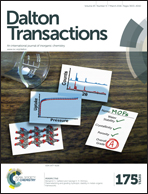Cyclometalated gold(iii) trioxadiborrin complexes: studies of the bonding and excited states†
Abstract
Trioxadiborrins are chelating ligands that assemble in dehydration reactions of boronic acids. They are structurally related to β-diketonate ligands, but have a 2-charge. Little is known of the bonding properties of trioxadiborrin ligands. Presented here are density-functional theory (DFT) studies of cyclometalated gold(III) trioxadiborrins. Substituent effects are evaluated, and comparison is made to the cyclometalating 2-(4-tolyl)pyridine (tpy) ligand on gold. The tpy ligand binds more strongly than any trioxadiborrin ligand considered here, and the two ligands bind competitively to gold. The 1,3-diphenyl trioxadiborrin ligand of 1 has a larger absolute binding enthalpy to gold than its β-diketonate analogue. Conjugation between boron and aryl substituents delocalizes charge and attenuates the trioxadiborrin's binding capacity. Steric effects that disrupt conjugation between boron and aryl substituents cause the trioxadiborrin to chelate more tightly. Fragment bond orders are divided into in-plane and out-of-plane contributions for square planar 1. In-plane bonding accounts for 88% of bond order between (tpy)Au2+ and the trioxadiborrin ligand. Cyclometalated gold(III) trioxadiborrin complexes were previously shown to be phosphorescent. Spin-unrestricted triplet-state geometry optimizations find that the ten largest excited-state distortions all occur on the tpy ligand. A plot of spin density in triplet 1 shows spin to reside predominantly on tpy. The 77 K luminescence spectrum of 1 is reported here. Time-dependent DFT and configuration interaction singles calculations (corrected for doubles excitations) overestimate the emission energy by ∼0.12 eV.


 Please wait while we load your content...
Please wait while we load your content...